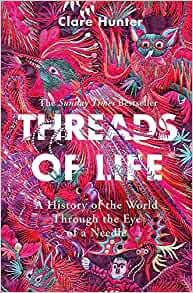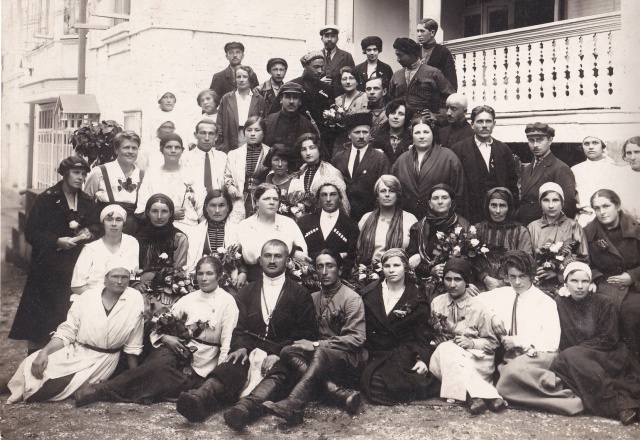
I found this book in a charity shop and it opened my eyes to a different world; the world of sewing and the important place it has in all of our memories. As a socialist I have marched behind and stood next to many banners over the years. Including those of my trade union, CND, miscarriage of justice cases …it is a long list. But I never thought about who made the banner and why banners are an important part of the political history of this country and across the world.
In “Threads of Life” Clare Hunter has brought together many examples of women and men using the language of sewing to express their lives, their hopes and dreams. Clare is a banner maker, community textile artist and textile curator. This is a fascinating history of sewing which unravels an art that has been undermined and forgotten. As Clare reminds us the process of sewing “has become separate from the object, the maker from what they have made, and with it we have lost its emotional and social potency”.
Clare traces her own love of sewing from her mother and how the whole process changed her life. She says “The absorption of needlework encouraged me to be stiller, quieter. But it also gave me another way to express myself.” Over the years she has taken that love of needlework and worked in some fascinating projects. I loved the story about Leith and working as part of a community to sew a banner to promote their community and dreams of a better life.
In this very short, but packed with history, book Clare shows how needlework was and is very important to all kinds of people from the disabled servicemen of the First World War who were taught to sew so they could make a living to the life of communist Ruth First who took up sewing in prison when she was refused the means to write.
Needlework and the production of banners has been one way that many people have used to show their anger and opposition to injustice. It is also one way of showing comradeship and the unity of people who sometimes cannot speak the same language. One banner I am thinking of is the one given to Mary Quaile and her comrades from the women and men of the Soviet Union in 1925.

Mary Quaile was a working class woman who through organisations such as the Manchester and Salford Women’s TUC worked hard to help recruit some of the poorest women workers (which included Jewish tailoresses) into trade unions to improve their lives. Her life changed because of her trade union activity and by 1925 she was leading a delegation of trade union women to the Soviet Union. The aim of the delegation was to investigate the changing lives of women under socialism and over four months they travelled widely across this vast and changing political landscape.
One of the few pictures that remains of the delegation is Mary and her sisters sitting with a group of Soviet women and men. Mary looks quite different – even wearing what looks like the dress of a local woman –and with a utilitarian bob hairdo.

Mary is fifth from the right on the second row from the front.
The delegation was given a beautiful banner as a present – but like many of these works of art – we do not know the story behind it – was it the women that Mary and her comrades met who wanted to thank her for reaching to them as women and comrades?
The power of banners is very important – not just in making a statement about the life of an organisation or cause – but sometimes reflects how the sewer wants to contribute to a particular cause. In 1994 I was involved with the Kate Magee Campaign – she was an Irish women, a single parent – who was arrested Following the shooting of an Army Careers Officer in Derby. Kate was arrested and charged with offences under the Prevention of Terrorism Act.
Many people were outraged with the way Kate and her children had been treated and the campaign brought in people from across the UK and the world to support her. Film maker Phil Donnellan and his wife Jill became involved, they put up the bail for Kate, took her and her kids into their home and hearts. Jill sewed this wonderful banner which was displayed outside Sheffield Crown Court during her trial and one around supporters would gather as the trial took place and Kate was found not guilty.

Jill is third from the left. Photo by Kevin Hayes
In this wonderful book Clare brings to life an important aspect of our history; needlework. As she says “ Sewing is a way to mark our existence on cloth; patterning our place in the world, voicing our identity, sharing something of ourselves with others and leaving the indelible evidence of our presence in stitches held fast by our touch.”
Buy it from here
I just love this review! So true–the products of women’s painstaking labor and creativity all all around us and so good that someone thought to write about this! One of my favorite memories of attending a tradeswomen’s conference in California was the opening parade of the union banners–beautiful! My sister [a seamstress among her many talents] made me the most beautiful quilt for this year’s birthday–using t-shirts from my lifetime of activism–so wonderful! I will be sharing this review with both of my sewing sisters. Thank you! PS: Years ago, I attended an exhibit on quilts at our American Folk Museum in NYC–such gorgeous quilts. Plus on my book tour in Cleveland, Ohio, went to the museum and saw yet another exhibit on quilts…so much history bound up in these treasures!
I really enjoyed this review Bernadette.It was a good reminder for me .I particularly appreciated your personal recollections on banners that have had a significance to you.Do you know where those banners are housed?There must have been so many that have disappeared. Thanks again,Laraine
Reblogged this on Anarchy in the Sticks!.